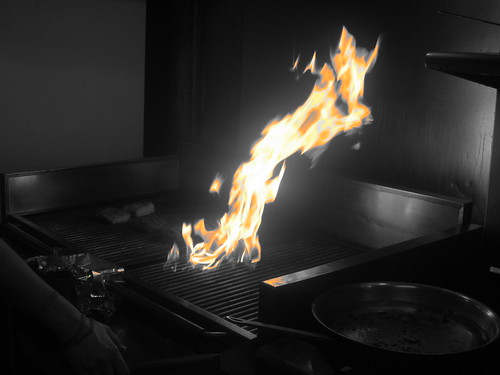Luckily for me, I have a boss that lets me play around with the food a little bit at work. And, one of the duties for kitchen staff is to prepare daily meals for everyone. It's a pretty good deal for the staff. Depending on what you get, you get a $20 to $40 meal free every day.
One of the ladies that works there has a sensitive stomach and almost always asks me for fish. So much so that it's gotten to the point that I'm just trying to find new ways to make fish for her that don't involve frying it. (Like all good Southern restaurants, we serve fried catfish.) And this week I decided on poached salmon for her. The catch... You have to have some sake around....
To make one serving you will need:
- 1 Six to seven ounce salmon filet (with skin)
- Sake (about a half a cup to start)
- Heavy Whipping Cream
- Chopped Onion (about 1 half of a small one)
- Chopped Garlic
- Quartered Shitake Mushroom Caps (about a half a cup)
- Fresh Chopped Oregano
- Fresh Chopped Rosemary
- Salt & Pepper
- One serving cooked wild rice
First you will want to start by saute'ing the chopped onion and the mushroom caps in oil over medium high heat until they are soft. Then add the garlic and continue saute'ing a few minutes more being careful not to let the garlic burn.
Next you will need to deglaze the pan with the sake. Just pour some in and stir it around, being sure to loosen anything that might have stuck to the bottom. Continue to cook until most of the sake cooks down. (For those of you who aren't experienced at cooking with alcohol -especially on gas ranges - you may want to consider turning the burner off for this part as just pouring this in will likely cause the flame to flare up if any splashes.)
Once the sake has cooked down, turn down the heat add the whipping cream. You'll need to add enough to the pan that it will almost cover the fish when you put it in. At this point, you may also add your herbs and season with salt and pepper.
Let the mixture cook another minute or two to combine flavors and then add your salmon skin side up. Now, once you get the salmon in there, you may notice that there's not quite enough liquid. That's okay. Just add more sake.
Now, you just need to let the salmon cook. Since the dish has a dairy product in it, you're going to want to keep the heat low so as not to burn it. Not a problem. For several reasons.
One, salmon is a fish you can cook and serve at different temperatures. Medium rare is generally preferred.
Two, it honestly won't take the salmon that long to cook.
And three, you can help facilitate the process by covering the dish with a lid.
Depending on the thickness of your fish, you'll want to start checking it in five minutes. Just remove the lid and feel the skin with the tip of your finger. If the skin isn't warm, it's not done. Give it a few more minutes and check again.
Once the salmon is cooked, remove it from the sauce and pour the sauce over the cooked rice you should already have prepared. Place the fish on the bed of rice, skin side down. And... If you're cooking for others and want to add some flare, sprinkle some whole fresh rosemary or oregano on the top.
A little note here... I know I didn't put any amounts on some of the items. That's okay. You don't need me to tell you how much of an item would have to be put in a dish to taste good to you. If you're unsure of a flavor, just start by adding a little an add more as you go along. With herbs in sauces, you can always add more toward the end without hurting the dish.
Also.. If you don't like an item in the dish. Don't be afraid to switch things up and put something to your liking in instead.
Anyway you go... If you try this and like it, let me know. If you tried it and changed something... Let me know that too
 RSS Feed
RSS Feed Twitter
Twitter




 11:05 AM
11:05 AM
 Unknown
Unknown











